|
Congratulations to...
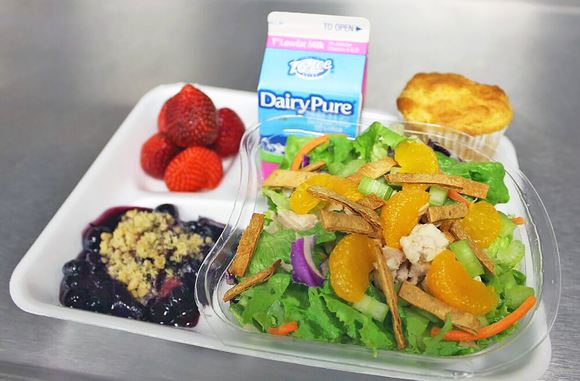
The November "Spotlight on Schools" e-letter announced
a photo contest to highlight
the wonderful meals that schools are preparing for students using USDA Foods. We received hundreds of submissions from schools throughout
the United States, and USDA staff assessed each entry for use of USDA Foods, creativity, and overall photo quality.
We enjoyed viewing the many worthy and inspiring photos, and narrowing them down to one winner was a difficult task!
Congratulations to Michael Cotroneo from Duval County
School District, who submitted Mandarin Chicken Salad, using USDA diced
chicken and whole wheat tortilla strips. The tray also featured USDA flour and eggs in the cornbread muffin and USDA blueberries and strawberries in the Berry Crisp.
Thank you to everyone who showed us your tray. It was wonderful
to see all of the fun and creative ways you are maximizing your USDA Foods!
On June 4,
1946, President Harry S. Truman signed the National School Lunch Act, which authorized the NSLP to provide
food to school age children while absorbing farm surpluses. We’ve come a long way since that Act was
signed. We want to share your memories
of USDA Foods from the 70s, 80s, and 90s. Send us copies of the USDA Foods order forms or your memories of
the products offered. Pictures of your
staff working with those foods are welcome, too!
We will publish a few of these pictures and memories in the
June e-letter. Send any of your
memories and pictures to LaNae Potter at LaNae.Potter@fns.usda.gov by May 31.

The School Year (SY) 16-17 USDA Foods Available List has been released, and
we are pleased to announce some new products and updates to current USDA Foods
products. We invite you to review the complete USDA Foods
Available List for SY 16-17.
Product Information Sheets are not available for
some new products since we have not yet contracted with vendors to understand
the full scope of suppliers and final nutrition formulations. As items
are contracted in early summer, we will begin developing and posting the
Product Information Sheets online. Check back during the summer for more
information about the nutrition profile of these products.
Fruits and
Vegetables - New:
- Red/Green Pepper and Onion Strips Blend, Frozen
- Sweet Potatoes, Crinkle Cut, Oven Fries, Frozen
- Cranberries, Dried, Individual Portion
- Orange Juice, Individual Cups
- Dry Legumes (garbanzo, great northern, pinto,
lentil) - 12/2 pound bags
- Frozen Fruits/Vegetables (apples, blueberries,
diced carrots, peas, spinach) - 12/2-2.5 pound bags
Fruits and
Vegetables - Reformulated:
- Dried Fruit Mix - Now includes a standard blend
of dried apples, raisins, cranberries, and cherries
- Sliced Carrots, Frozen - Added maximum diameter
of 1.5”
Meat/Meat
Alternate - New:
- Pulled Pork, Unseasoned
- Beef Patty, Cooked, No Soy
- Tuna, Canned
- Peanut Butter, Individual Portion
Meat/Meat
Alternate - Reformulated:
- Ham - Dice size increased to ½ inch
- Chicken Fajita - Sodium decreased to 500 mg/100 g
portion
- Chicken, Canned - Changed to all white meat formulation
Whole
Grains:
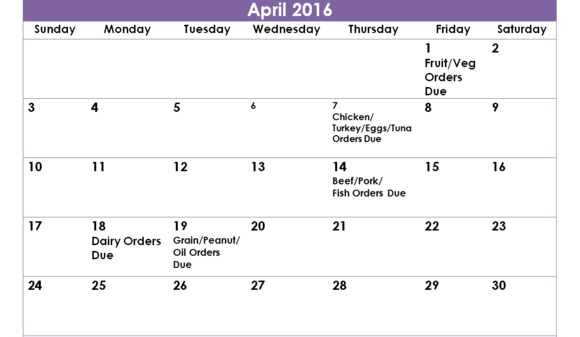
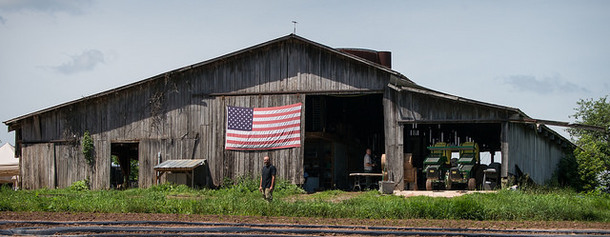
March is National Nutrition Month. Throughout the month, USDA highlighted results of our efforts to improve access to safe, healthy food for all Americans and support the health of our next generation.
Fish and fowl, sowing and reaping, nutrition and agriculture… certain words and concepts naturally go hand in hand, and March is a month to celebrate both the foundation and purpose of the American food system. With March designated as National Nutrition Month and March 15 as National Agriculture Day, the time is ripe to reflect on healthy eating goals and to express gratitude for the farmers, fishers, and ranchers who provide the foods to fuel our nation. Read more
Updated White Paper on USDA Foods in the National School Lunch Program
USDA recently released
an updated white paper detailing how USDA Foods are provided to the National School
Lunch Program (NSLP). Topics covered include funding sources for USDA
Foods in the NSLP, the USDA Foods Available List, and the variety and
nutritional content of USDA Foods offered in NSLP. The paper is posted on the Food Distribution Programs website.
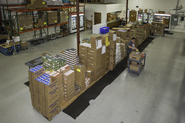 Storage Conditions
Summertime is almost here! It is important for all Recipient Agencies and Indian Tribal Organizations to know appropriate techniques for preparing USDA Foods for proper storage during the summer months. Planning ahead will help products maintain their optimal quality and freshness. Dry storage areas should ideally be maintained at a temperature of 70º F or below unless other recommended storage directions are provided. Conversely, USDA Foods placed in a freezer (0º F or below) or a refrigeration unit (40º F or below) should remain in these storage conditions until they are ready to be used. This prevents condensation which can lead to mold, insect infestation, the deterioration of bagged/boxed goods, or rusty cans. Storage condition temperatures of USDA Foods should be recorded daily to ensure the integrity of the USDA Foods is maintained, noting any deficiencies and corrections. By taking the necessary precautions and following purchasing specifications, food losses can be reduced or prevented.
Are you interested in
specific information on storing fresh produce? Review these Best Practices: Handling Fresh Produce in Schools.
The Complaint Team is available Monday-Friday, 6:00 a.m. – 5:00 p.m. Eastern Time. Email USDAFoodsComplaints@fns.usda.gov or call the USDA Foods Complaint Hotline at 800-446-6991.
|
USDA is managing
a pilot program for the use of the Department of Defense (DoD) Fresh Fruit and
Vegetable Program in the Summer Food Service Program (SFSP) for SY 16. The SFSP ensures that low-income children
continue to receive nutritious meals when school is not in session. Through
this pilot program, states will be allowed to use SFSP USDA Foods entitlement
dollars to buy fresh fruits and vegetables during the summer. This will offer sponsors
a wider variety of fresh produce for healthy meals. States were asked to indicate their interest
in participating in this valuable opportunity by the end of February. All
states that expressed interest will be interviewed and those who are compatible
with DoD requirements will be selected in March. If you have any questions
about participating in this pilot program, please contact Janet West at Janet.West@fns.usda.gov.
-Apple -Broccoli -Carrot -Corn -Orange
-Pear -Pepper -Sweet Potato -Vegetable
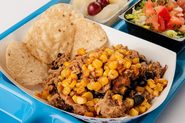 One of the new products available through USDA Foods this year is unseasoned pulled pork. This pre-cooked pork has a basic flavor profile, so it can be adapted for use in a variety of applications. Please see the recipe below for one way this product can be used in your school menus.
Photo Courtesy of: Kelly Flora Photography, Inc.
|
Recipe: Mexican Burrito Bowl with Pork and Black Beans
TCS Process: #2 Same Day Service Group
Code: Entrée - Hot
Number of Portions: 32 Portion
Size: 1 bowl
Meal Contribution: 2 M/MA; ½ c Legume
V; ¼ c starchy V; 2 WGR G
 *Item available through USDA Foods
TCS Processes: Non-TCS Food; #1 No Cook; #2 Same Day Service; #3 Complex
Recipe developed
for North Carolina K12 Culinary Institute: Smarter Meals, Successful Students and
shared courtesy of Chef Cyndie and the K12 Culinary Team: Chef Garrett Berdan, RDN; Chef Carlin
Breinig; Chef Chris Lester; Chef Lindsey Schoenfeld, RDN; Chef Vahista Ussery,
MBA, RDN
Helpful Resources for WBSCM Users
New and experienced users alike can find several useful resources that provide instructions, guidance, and general support information to help them work proficiently with Web-Based Supply Chain Management (WBSCM). These materials are regularly updated to correspond to the current best practices, application enhancements, and system requirements to provide convenient solutions to common questions.
USDA Website: Technical information and news about WBSCM on the public website includes Technical Information & Tools such as system requirements, browser settings, and technical tips; Upload/Download Guidelines & Templates for bulk updates and data integration with other systems; and a Newsletter Archive, which contains updates and reminders about WBSCM features, upcoming events, and Service Desk-recommended solutions to common problems.
WBSCM Forum: When logged in to WBSCM, users can see one or more discussion forums, depending upon their role in the system. These are used to announce new software releases, system outages, changes to browser or system requirements, upcoming deadlines, etc. Within WBSCM, navigate to Home -> News and Alerts.
Work Instructions: Step-by-step instructions and screenshots are available for common processes. These can be located by browsing by role and business function: Internal/External, Fulfillment/Procurement, and Domestic/International. A keyword search tool is also available after selecting a category. These materials can be accessed as simple or detailed instructions; many can also be viewed as interactive on-screen simulations. Within WBSCM, navigate to Help -> Training -> Work Instructions.
Job Aids: These are miscellaneous references to assist users with WBSCM. Examples include general instructions for running different types of reports, helpful hints, guidance for using wildcard characters in searches, and business rules. These resources are grouped by category: Finance, Fulfillment, Procurement, and Reports. Within WBSCM, navigate to Help -> Training -> Job Aids.
Release Notes: WBSCM is under continuous development to address known issues and/or introduce new or enhanced features. A description of the changes, the roles impacted, and links to related instructions are published with each release. Within WBSCM, navigate to Help -> Training -> Release Notes. The newest items can be found at the bottom of the list.
Hands-on Training: The WBSCM training environment (NTRN) is available for a variety of user roles. This safe environment provides trainers, trainees, and those who just want to practice using WBSCM with a copy of production data from 11/1/2013 from WBSCM for training on reports, placing orders, and more—all without impacting any real account activity. Contact the main WBSCM Service Desk at 877-WBSCM-4U (877-927-2648) or by email to WBSCMHelp@ams.usda.gov if you want access to NTRN.
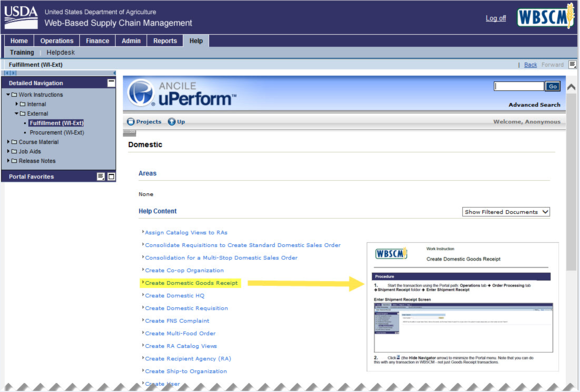 WBSCM Work Instruction Example
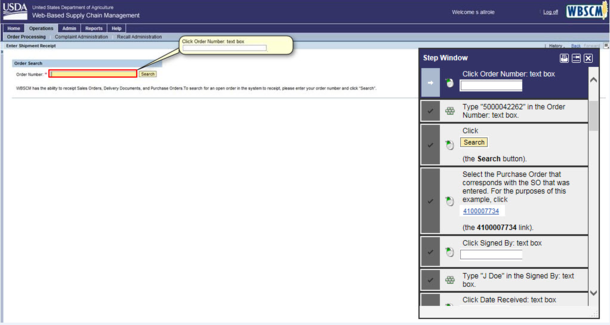 WBSCM Simulation Example
Tomatoes are the most widely grown vegetable and can probably be found in most home gardens. We did a little digging and found some interesting facts about tomatoes.
Which country is the biggest producer of tomatoes? According to USDA, China comes first in tomato production followed by the United States.
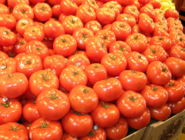 Where do all these tomatoes go? Most of the tomatoes grown go to two markets: fresh tomatoes (what we put on a salad) and processed tomato products like USDA purchases (e.g. spaghetti sauce and salsa) or school districts' processed end-products (e.g. pizza sauce and ketsup). Tomatoes bound for processing generally have a thicker skin and firmer consistency; these qualities decrease the chance of damage to the vegetable during harvesting and transportation.
Which State is the biggest U.S. producer of fresh tomatoes? Florida is the number one producer of fresh market tomatoes.
Which State is the biggest U.S. producer of processed tomatoes? California produces 96% of the tomatoes processed in the U.S. The Midwest—Indiana, Ohio, and Michigan—makes up most of the remaining tomato production headed for processing. Typically, growers contract with processors to process ripe tomatoes. These processors, in turn, use the tomatoes to produce canned tomatoes and tomato paste, the building block for many soups and sauces. Tomato production statistics and more can be found on USDA’s National Agricultural Statistics Service website.
Which States provide USDA Foods tomato products? In Fiscal Year 2015, USDA purchased 50 million pounds of tomato products, spending about $20 million. The chart below shows the quantity of tomato products in pounds purchased by State for use in the USDA Foods programs.
|
 Still wondering if tomatoes are vegetables or fruits? Botanically, a tomato is technically a fruit because it is a ripened ovary of a plant. But for trade purposes a tomato is considered a vegetable. The identity crisis stems from an 1893 Supreme Court ruling that classified the tomato as a vegetable so it could be taxed under tariff law. In the context of NSLP, a tomato is in the red/orange vegetable subgroup.
Knowledge is knowing a tomato is a fruit; wisdom is knowing not to put a tomato in a fruit salad!
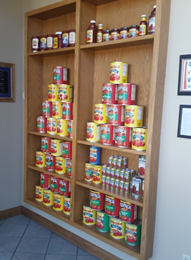 Ever wonder how tomatoes are processed and stored? USDA staff traveled to Elwood, Indiana, in September 2015 to visit Red Gold, both a USDA national processor and a USDA vendor supplying direct ship tomato products, to learn about that and more.
The Red Gold staff exhibited plenty of Midwest hospitality and was very helpful and friendly. Red Gold, a family corporation celebrating over 70 years of business, is the largest privately held tomato processor in the world.
Red Gold has several local growing fields and contracts with 50 family farms to grow tomatoes in Indiana, Michigan, and Ohio. Elwood, Indiana, is home to the corporate headquarters. Additional Indiana facilities include production facilities in Geneva and Orestes and a distribution center in Alexandria. The company has a big focus on sustainability.
|
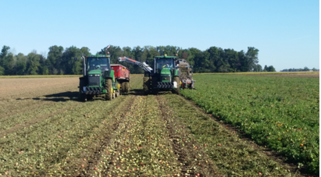 Red Gold is a completely vertically integrated tomato processor, starting with the development of seeds to managing the tomato growing fields. The sorting process at the field was a delight to see, with sorting crews, who work on each side of this sorting machine, working as an assembly line. The machine is continually moving along the field pulling whole tomato plants into it, removing the fruit from the vine, and returning the vine back into the field. Tomatoes are sent to where crew members rapidly separate bad tomatoes from good tomatoes, allowing only the good ones to move into staging crates that will be moved to their processing plants.
After the tomatoes are sorted by the machine, on to the processing plant they go. The tomato trucks unload the tomatoes to another sorting machine that makes sure that the tomatoes are cleaned and sorted by color and ripeness. Next they are separated by what products they are going to become. For example, are they more suited for marinara sauce or salsa? Many are destined to be stored as paste in 2,000-pound totes for processing throughout the year into spaghetti sauce, pizza sauce, salsa and 6/#10 cans of paste and tomato sauce.
The trip was a wonderful experience, and everyone should visit a tomato processor if given the opportunity. Reach
out to a tomato processor in your area and experience it for yourself!
|
Q. What are the different types of
contracts most commonly used by USDA to purchase fruits and vegetables, and why are they necessary?
A. The type of contract and
purchase cycle for a fruit or vegetable product depends on the planting,
harvest, production and how a food can be stored.
- IDIQ - Indefinite
Delivery/Indefinite Quantity – IDIQ contracts specify a minimum and a maximum quantity to
be purchased. IDIQ contracts are
used for fruit and vegetable products that are harvested one time per year and
packed immediately in their final form. This
method is used to ensure the quantity needed for the crop year is packed to
USDA specifications, but there is flexibility for when or where loads will be
delivered. Prices are generally bid to each State and include additional
risk since the offeror doesn’t know where within a State the product must be
delivered. The winning contractor will pack the maximum quantity of
product awarded and then deliver throughout the year when provided with sales
order requested delivery date and ship-to information. After the contract is awarded, purchase
orders are issued against them throughout the year. While the quantities
ordered have some flexibility, since the product is packed to a non-commercial
specification, USDA guarantees purchases of these specially packed
products. The quantities, therefore, are
not so “indefinite.” USDA requests orders
in advance from States to determine the maximum quantity to purchase for a crop
year for October to September delivery.
-
Quarterly Invitation For Bids
(IFB) – Quarterly
IFBs require firm sales orders. IFBs are used for products that are
available year-round and are produced from inventory and therefore require a
shorter lead time. Quarterly solicitations
state exactly how much product will be delivered, where and when. Prices
are based on this information. Contracts are awarded for a firm quantity
and a fixed price to specific destinations. Given the year-round availability of these products, States may order
quarterly throughout the school year.
-
Seasonal Invitation
For Bids – The only
difference between seasonal and quarterly IFBs is the timing and
frequency. IFBs are used instead of IDIQs because the locations and
timeframes are known at the outset of the contract. Typically States can
order these products twice a year or yearly.
Q. Which USDA fruits and
vegetables are purchased on IDIQ contracts?
A. The following products are either canned or frozen at the time of
harvest. Additionally, the vegetable acreage for the IDIQ vegetables below must
be contracted for at the time of planting no later than May. Harvest and packing
of these items can go from July to September.
Q. Which USDA fruits and vegetables are purchased on a quarterly basis?
A. Quarterly products processed throughout the year are listed below. Apples are stored fresh and processed. The dried fruit products are stored in bulk after drying and then packaged. Orange juice concentrate is stored in liquid tankards for reconstitution and packaging. Tomato products are processed from 2,000-pound bulk totes. Dried bean products are processed from bulk dried beans and are either repackaged or cooked and canned.
Q. Which USDA fruits and vegetables are purchased on a bi-annual basis?
A. The products below are offered twice a year subject to availability of fresh bulk apple and potato inventory that meets grade. Broccoli has two growing seasons and is available twice a year subject to successful harvests.
Q. Which USDA fruits and vegetables are purchased on an annual basis?
A. The following are purchased once a year due to the limited demand and the seasonal availability.
Q. What are the early harvested fruit and vegetable materials and what procedures does USDA take to help in purchasing these products?
A. Apricots and strawberries are the fruits that are harvested the earliest. Frozen strawberries are actually a secondary market of the fresh strawberry market. If the fresh market is weak, more strawberries get processed into frozen products. If the fresh market is strong, more strawberries are sold fresh, leaving less available for frozen items. This is why it is important for contractors to know ahead of time how much frozen product USDA will want, so they can make sure at least that much is available in the event of a strong fresh market.
In addition, USDA specifications can be slightly different from commercial specifications. Any product packed in syrup or with lower sodium has to be contracted before it is processed. For example, peas begin harvest in June. Once a pea is harvested, it is in the can within a day or two; therefore, the contractor needs to know what kind of packing medium to use before that pea ever comes off the vine. USDA asks its customers for demand in April so that contracts can be in place before harvest to ensure enough product will be produced to USDA specifications.
Q. What role does industry/market play in determining when USDA purchases various materials?
A. The industry plays a large role in telling USDA when products are best purchased. The entire purchase schedule is based on industry feedback about when products can be purchased, how much lead time is needed, and how far deliveries can be planned in the future. Industry also notifies USDA if the harvest is late or early (due to Mother Nature) as well as if there are any shortages or surpluses. USDA staff maintain constant communication with industry to monitor changes in fruit and vegetable varieties that might change the timing of purchases. Generally, drastic changes are not made to USDA's purchase schedule without first consulting with the industry.
USDA staff will be participating in these upcoming national meetings in 2016. We look forward to these opportunities to meet you and hope to see you there!
May 9-11: American Commodity Distribution Association (ACDA) Annual Conference in St. Pete Beach, Florida
July 10-13: School Nutrition Association (SNA) Annual National Conference in San Antonio, Texas
 Here's how to sign up for these updates via GovDelivery:
1. Go to the Food Distribution website.
2. Click on the red envelope on the row of social media icons on the top right of the page.
3. Enter your email address and click "Submit."
4. Check the boxes to select your topics of interest. For these e-letters, scroll down to the Food Distribution category and click the plus sign to the left of the check box to expand the list and view all the sub-categories. Check these sub-categories to receive the corresponding e-letters:
*USDA Foods --> receive all "USDA Foods from Farm to Plate" general + program-specific e-letters
*Commodity Supplemental Food Program (CSFP) --> receive "Household Highlights" e-letter
*The Emergency Food Assistance Program (TEFAP) --> receive "Household Highlights" e-letter
*Food Distribution Program on Indian Reservations (FDPIR) --> receive "FDPIR Connection" e-letter
*Schools/Child Nutrition Commodity Programs --> receive "Spotlight on Schools" e-letter
5. Update your subscription preferences any time by following the above steps or clicking on the Subscriber Preferences Page link at the bottom of any of the e-letter email messages you receive from GovDelivery. Questions? Contact us at USDAFoods@fns.usda.gov.
|
|